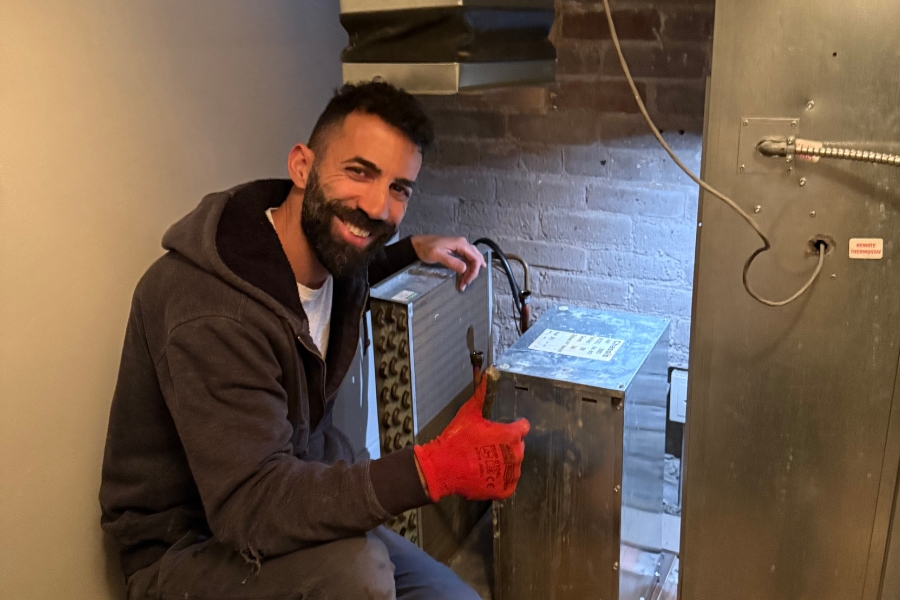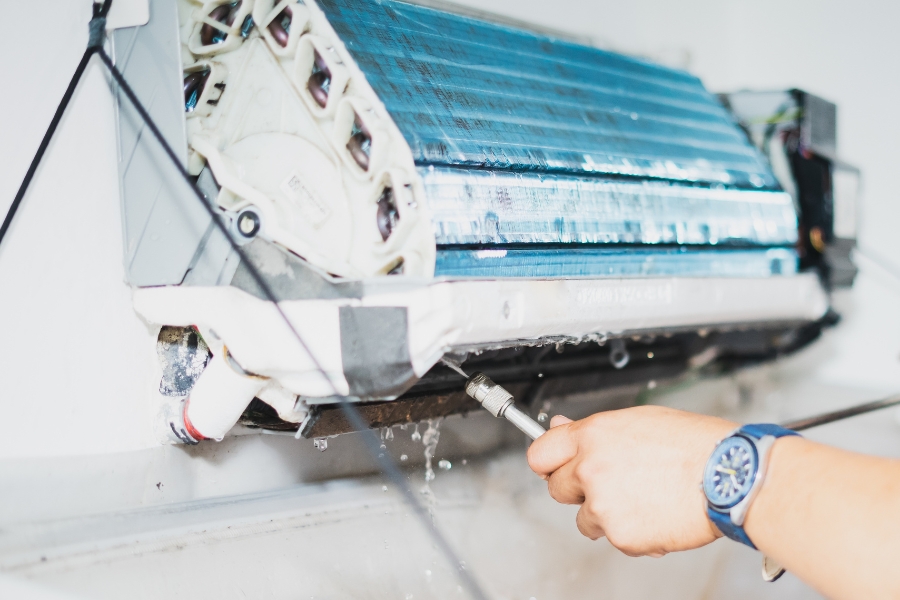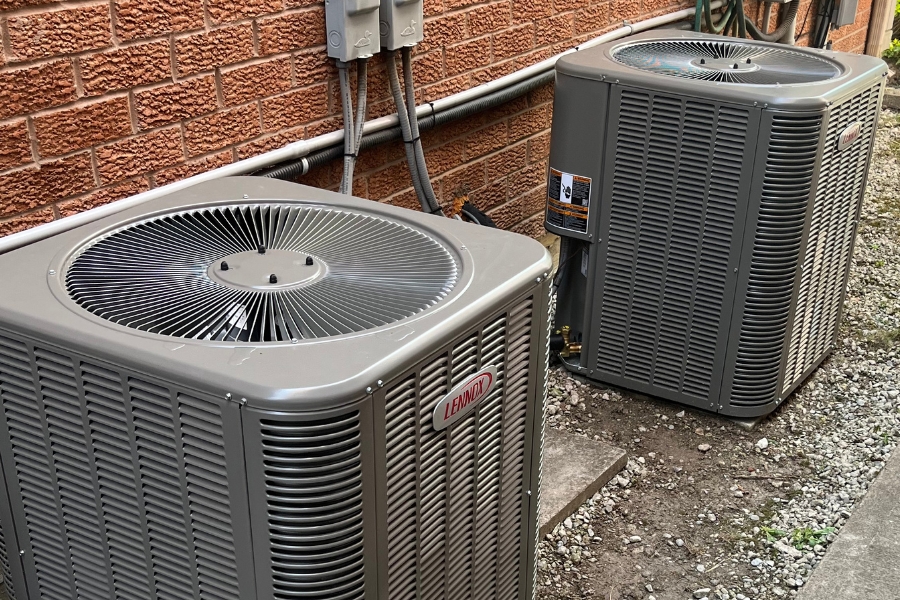Short cycling is when your air conditioning (AC) turns on and off on its own. This abruptly stops the AC cycle, making it hard for the AC to circulate the cooling around your home.
This AC short cycling not only makes your home uncomfortable but also puts extra strain on the system. A healthy AC unit should run for about 10 to 15 minutes during each cycle, depending on the outdoor temperature. When short cycling occurs, the system never gets into a steady rhythm, leading to uneven cooling, higher energy bills, and more wear and tear on internal parts.
Common Causes of AC Short Cycling
Short cycling can happen for several reasons, most of which are either easy to spot or relatively simple to fix. Let’s look at some of the most common causes behind AC short cycling so you can get back on track to a cooler home. We’ll also highlight some DIY solutions that you can conduct before calling us to repair your cooling unit.

Dirty Air Filter Causing AC Short Cycling
One of the most common causes of AC short cycling is a dirty or clogged air filter. Just by being in and around your home, an AC can accumulate dust particles, human and pet hair, and other debris while on the clock. This blocks the air filter from working efficiently, leading to restricted airflow. This results in your system shutting down early.
DIY Solution for Cleaning a Dirty AC Air Filter
First, check if your air filter is reusable. You should check the manufacturer’s instruction for cleaning if it’s possible. Most of the time, you can clean it yourself to remove dust and debris. Using a vacuum, a gentle water source (like a hose or shower head), or a warm, soapy water soak, you can successfully clean your filter alone.
If it’s not washable or you have a feeling that it’s a little too dirty to clean on your own, replace it with a new one that matches your system’s specifications. Most filters cost between $10 to $25 and can be found at local hardware stores or online.
Thermostat Issues
A malfunctioning thermostat or one placed in the wrong location can trick your AC into thinking the room is already cool, even if it’s not. For example, if it’s near a window or a heat source like a lamp or electronics, it may misread the actual room temperature.
How to Fix Thermostat Placement on your Own
Make sure your thermostat isn’t exposed to direct sunlight or heat sources. Try moving any nearby lamps or electronics away from it. If you have a programmable thermostat, double-check the settings to make sure they’re accurate.
If your thermostat is still not picking up a good read, you can replace it with a new thermostat system.
Icy Coils in your AC Unit
Frozen evaporator coils can block airflow and cause your system to shut off unexpectedly. This issue often concerns the evaporator coil. If the evaporator coil cannot absorb heat, it’ll leave any refrigerant in its tube below freezing. The moisture produced by this will freeze and cause icy coils.
How To Melt The Ice In Your AC
Turn off your AC and let the ice melt completely on its own. Don’t try to thaw it with any external sources otherwise, it can cause more problems. While it will take a few hours, it’s worth the wait to fix your AC once and for all. Once all the ice melted, check and clean or replace the air filter by following the same steps we mentioned above.

Outdoor Unit Obstructions
The outside unit (condenser) needs good airflow to release heat effectively. If it’s surrounded by bushes, leaves, or some other blockage, the system can overheat and shut down too soon.
Clearing Your Condenser By Yourself
Clear away any plants, dirt, or clutter around the outdoor unit. Aim for at least two feet of clear space on all sides. You can gently hose off the fins (the slats on the outside unit) to remove built-up dust but avoid using high pressure.

Oversized AC Unit
Sometimes, the AC system itself is simply too big for the space it’s trying to cool. An oversized unit cools the space too quickly without removing humidity, causing it to shut off frequently. Here’s a chart on how many BTUs you should look for in an AC unit depending on the area you’re trying to cool:
| Room Size (Square Feet) | Recommended BTUs |
|---|---|
| 100–200 sq. ft. | 9,000 BTUs |
| 200–400 sq. ft. | 12,000 BTUs |
| 400–600 sq. ft. | 18,000 BTUs |
| 600–1,000 sq. ft. | 24,000 BTUs |
| 1,000–1,200 sq. ft. | 30,000 BTUs |
A Solution That Calls For the Pros
While you can’t change the size of your unit overnight, you can improve efficiency by making sure vents are open, filters are clean, and rooms are well-insulated. However, this is usually a design flaw that requires professional evaluation in the long term.
How To Prevent Short Cycling in Your AC
Preventing AC short cycling starts with regular maintenance and smart usage habits. Here are some habits to pick up over the summer when your AC is needed most:
- Change/clean filters regularly: A clean filter improves airflow and helps your system run better.
- Keep vents open and unblocked: Make sure furniture, rugs, or curtains aren’t covering air vents.
- Clean the outdoor unit: At least once per season, give the outside condenser a gentle cleaning by picking up any large blockages and cleaning away any debris.
- Check thermostat placement: Again, make sure it’s avoiding heat sources or any other items that may be causing its reading to come out as inaccurate.
- Use ceiling fans: They help circulate cool air, reducing the load on your AC. Place ceiling fans that rotate counterclockwise to get the air flowing in the right direction where its needed most.
- Seal windows and doors when your AC is running: Keeping cool air inside means less work for your system. Don’t let that precious cool air go to waste.
- Monitor your AC unit: Pay attention to how often your AC cycles on and off. If you notice it’s short cycling, check all of the issues we mentioned above.
Stay alert and give your AC that TLC it deserves to keep you cool during warmer seasons.
Say Bye to AC Short Cycling!
The great part about this is that you can check a lot of these issues for yourself. That being said, it’s important to know when to call for backup. Every AC and home has its differences, and we understand that. So, get to know your AC and learn the secret language it’s using to communicate with you. Who knows? Maybe you’ll get a lesson out of it.
That being said, we at Heat Flow HVAC are here to help you when you need it. Don’t hesitate to call us when you need your AC to run smoothly again!